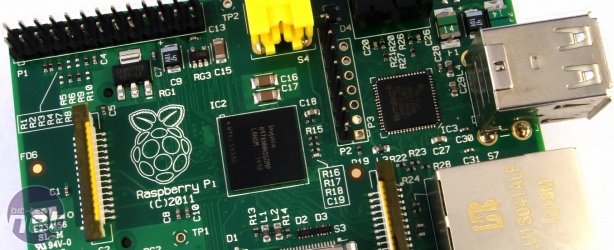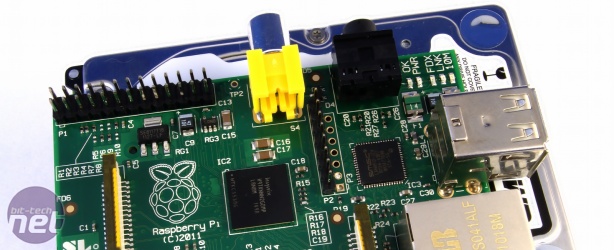Raspberry Pi review
April 16, 2012 | 14:24
Companies: #arm #broadcom #hynix #raspberry-pi #raspberry-pi-foundation

The Raspberry Pi is to be made available in two editions: the Model A, and the Model B. Named for the differing editions of the classic BBC Micro from British computing giant Acorn, the two models differ only in their capabilities: the B has a 10/100M Ethernet jack and two USB ports to the A's single port and lack of any form of on-board networking.
For now, only the Model B is being produced. At its heart is a Broadcom BCM2835 system-on-chip processor running at 700MHz, with a VideoCore IV GPU running at 250MHz. A single 256MB module of Hynix LPDDR memory running at 400MHz provides RAM for both the CPU and GPU, with the typical split leaving around 186MB of memory available for the user.
If you're wondering why you can't see the Broadcom SoC anywhere on the Raspberry Pi, it's because you're looking in the wrong place. The processor is hidden beneath the Hynix memory chip at the centre of the board, which uses a package-on-package (PoP) mounting process to create a RAM-SoC sandwich.
Connectors around every edge of the board provide input, in the form of a microUSB power socket and two USB 2.0 ports, and output with HDMI, 3.5mm audio and RCA composite video all present and correct. For those looking to use the board in an embedded environment, there's also a Display Serial Interconnect (DSI) connector for flat-panel displays and - exclusive to the Model B - a MIPI camera connector.
The underside of the board is pretty barren, with nothing much to see save for a collection of surface-mount resistors, capacitors and a couple of crystals. The sole exception is the SD card slot, which provides the Raspberry Pi with its only form of on-device storage. While basic, the connector serves its purpose - although if you're thinking of building a case, it's worth mentioning that the SD card sticks out around 17mm beyond the edge of the board.
This, plus a proud-sitting pair of USB ports and the RCA jack, gives the Pi an overall size of around 109mm x 63mm. With the 'official' size of the board - measured purely in terms of the area of the PCB - being 85.60mm x 53.98mm, that's a significant extra bit of space for box-builders to find.
For now, only the Model B is being produced. At its heart is a Broadcom BCM2835 system-on-chip processor running at 700MHz, with a VideoCore IV GPU running at 250MHz. A single 256MB module of Hynix LPDDR memory running at 400MHz provides RAM for both the CPU and GPU, with the typical split leaving around 186MB of memory available for the user.
If you're wondering why you can't see the Broadcom SoC anywhere on the Raspberry Pi, it's because you're looking in the wrong place. The processor is hidden beneath the Hynix memory chip at the centre of the board, which uses a package-on-package (PoP) mounting process to create a RAM-SoC sandwich.
Connectors around every edge of the board provide input, in the form of a microUSB power socket and two USB 2.0 ports, and output with HDMI, 3.5mm audio and RCA composite video all present and correct. For those looking to use the board in an embedded environment, there's also a Display Serial Interconnect (DSI) connector for flat-panel displays and - exclusive to the Model B - a MIPI camera connector.
The underside of the board is pretty barren, with nothing much to see save for a collection of surface-mount resistors, capacitors and a couple of crystals. The sole exception is the SD card slot, which provides the Raspberry Pi with its only form of on-device storage. While basic, the connector serves its purpose - although if you're thinking of building a case, it's worth mentioning that the SD card sticks out around 17mm beyond the edge of the board.
This, plus a proud-sitting pair of USB ports and the RCA jack, gives the Pi an overall size of around 109mm x 63mm. With the 'official' size of the board - measured purely in terms of the area of the PCB - being 85.60mm x 53.98mm, that's a significant extra bit of space for box-builders to find.

MSI MPG Velox 100R Chassis Review
October 14 2021 | 15:04










Want to comment? Please log in.